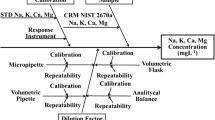Abstract
The quantification of target analytes in complex matrices requires special calibration approaches to compensate for additional capacity or activity in the matrix samples. The standard addition is one of the most important calibration procedures for quantification of analytes in such matrices. However, this technique requires a great number of reagents and material, and its consumes a considerable amount of time throughout the analysis. In this work, a new calibration procedure to analyze biological samples is proposed. The proposed calibration, called the addition calibration technique, was used for the determination of zinc (Zn) in blood serum and erythrocyte samples. The results obtained were compared with those obtained using conventional calibration techniques (standard addition and standard calibration). The proposed addition calibration was validated by recovery tests using blood samples spiked with Zn. The range of recovery for blood serum and erythrocyte samples were 90–132% and 76–112%, respectively. Statistical studies among results obtained by the addition technique and conventional techniques, using a paired two-tailed Student's t-test and linear regression, demonstrated good agreement among them.
Similar content being viewed by others
References
M. Speich, A. Pineau, and F. Ballereau, Minerals trace elements and related biological variables in athletes and during physical activity, Clin. Chim. Acta 312, 1–11 (2001).
E. Mocchegiani, M. Muzzioli, C. Cipriano, and R. Giacconi, Zinc, T-cell pathways, aging: role of metallothioneins, Mech Aging Dev. 106, 183–204 (1978).
J. Raulin, Etudes cliniques sur la vegetation, Ann Sci Natl Botam Biol Vegetale 11, 93 (1869).
W. R. Tood, C. A. Elvehjem, and E. B. Hart, Zinc in the nutrition of the rat, Am. J. Physiol. 107, 146–156 (1934).
L. A. Gaetke and C. K. Chow, Copper toxicity, oxidative stress, and antioxidant nutrients, Toxocology 189, 147–163 (2003).
H. H. Sandstead, Causes of iron and zinc deficiencies and their effects on brain, J. Nutr. 130, 3475–3495 (2001).
R. S. Gibson, A. L. Heath, M. L. Limbaga, N. Prosser, and C. M. Skeaff, Are changes in food consumption patterns associated with lower biochemical zinc status among women from Dunedin, New Zealand? Br. J. Nutr. 86, 71–80 (1990).
B. Welz and M. Sperling, Atomic Absorption Spectrometry, 3th ed., VHC, Weinheim (1999).
J. Scancar, R. Milacic, M. Benedik, and I. Krizaj, Total metal concentrations in serum of dialysis patients and fractionation of Cu, Rb, Al, Fe and Zn in spent continuons ambulatory periotoneal dialysis fluids, Talanta 59, 355–364 (2003).
R. Pamphlett, R. Mcquilty, and K. Zarkos, Blood levels of toxic and essential metals in motor neuron disease, Neurotoxicology 22, 401–410 (2001).
P. R. M. Correia, E. Oliveira, and P. V. Oliveira, Minimalism approach for determination of Cu, Fe, and Zn in serum by simultaneous electrothermal atomic absorption spectrometry, Anal. Chim. Acta 458, 321–329 (2002).
R. Honda, K. Tawara, M. Nishijo, H. Nakagawa, K. Tanebe, and S. Saito, Cadmiun exposure and trace elements in human breast milk, Toxicology 186, 255–259 (2002).
B. Welz, H. Becker-Ross, S. Florek, U. Heitmann, and M. G. R. Vale, High-resolution continuum-source atomic absorption spectrometry: What can we? J. Braz. Chem. Soc. 14, 220–229 (2002).
D. Mafra and S. M. F. Cozzolino, Erythrocyte zinc and carbonic anhydrase levels in nondialyzed chronic kidney disease patients, Clin. Biochem. 37, 67–71 (2004).
N. Maniasso, Ambientes micelares em qu Quim. Nova 24, 87–93 (2001).
M. A. Vieira, B. Welz, and A. J. Curtius, Determination of arsenic in sediments, coal and fly ash slurries after ultrasonic treatment by hydrice generation atomic absorption spectrometry and trapping in an iridium-treated graphite tube, Spectrochim. Acta B 7, 2057–2067 (2002).
F. J. Krug, M. M. Silva, and P. V. Oliveira, Determination of lead in blood by tungsten coil electrothermal atomic absorption spectrometry, Spectrochim. Acta B 50, 1469–1474 (1995).
D. W. Armstrong, Mechanism of enhancement of analyte sensitivity by surfactants in flame atomic spectrometry, Anal. Chem. 54, 1325–1329 (1982).
J. Mora, A. Canals, and V. J. Hernandis, Effect of long-chain surfactants on drop size distribution, transport efficiencyand sensitivity in flame atomic absorption spectrometry with pneumatic nebulization, J. Anal. Atomic Spectrom. 6, 139–143 (1991).
D. Y. Pharr, H. E. Selnau, E. A. Pickral, and R. L. Gordon, Enhancement effects of dodecyl sulphates in flame atomic absorption spectrometry, Anal. Chem. 116, 511–515 (1991).
Author information
Authors and Affiliations
Rights and permissions
About this article
Cite this article
Dutra, R.L., Cantos, G.A. & Carasek, E. Analysis of zinc in biological samples by flame atomic absorption spectrometry. Biol Trace Elem Res 111, 265–279 (2006). https://doi.org/10.1385/BTER:111:1:265
Received:
Accepted:
Issue Date:
DOI: https://doi.org/10.1385/BTER:111:1:265




